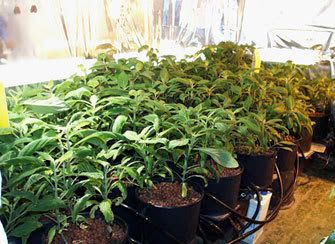There are many things that can complicate feeding your plants hydroponically. It can be hard enough trying to feed the right strength and right ratios of N-P-K, let alone trying to figure out trace nutrients and secondary nutrients. Once you get past these basics, you must consider plant vitamins, hormones, and keeping everything at the right Ph. If you are just starting out and you only have 20 bucks in your pocket and a teaspoon, this is written for you. I recommend you eventually get a ph meter and a TDS (or EC) meter if you are serious.
The first ten days your plants have roots, feed them 400 ppm Maxsea 3-20-20. This is about 1 level teaspoon/gallon of tap water. Add to this 1/4 teaspoon epsom salts for magnesium.
After that, feed them 600 ppm Maxsea 16-16-16. This is about 1 rounded teaspoon. To each gallon add 1/4 teaspoon epsom salts.
When you are finished with vegatative growth and begin flowering, feed your garden a rounded 1/2 tsp Maxsea 16-16-16 plus a rounded 1/2 tsp Maxsea 3-20-20 in each gallon of water. Be especially sure to add 1/4 tsp epsom salts to each gallon through the flowering stage. I used to switch to straight Maxsea 3-20-20 at this point, but most plants look a little nitrogen deficient by the end. Feed your garden in this way for two weeks, while the plants transition from vegatative growth to flowering.
After the transitioning period, feed your garden 800 ppm Maxsea 3-20-20 until you near the end of flowering. This is about 2 level teaspoons per gallon. Make sure to add 1/4 tsp epsom salts to each gallon. The very last 10 to 14 days before you harvest, you will want to feed your garden only plain water. Flushing you garden will remove excess nutrient salts from the plant tissue and will improve the aroma and flavor of your garden produce.
Seaweed additives are a popular choice when it comes to trace nutrients and plant hormone supplements. Since Maxsea fertalizers are seaweed based fertalizers, these benefits are built in and no additional supplements are required for these two things.
When you mix up Maxsea in a nutrient solution, it is a nearly perfect Ph. What's more, the Ph is stable in solution for many days. This is great for the beginning hydroponics gardener. This means you can get away without the initial cost of an expensive Ph meter in the beginning.
By carefully measuring the fertalizer when you mix up the nutrient solution, you can get away without the initial cost of an expensive TDS meter or EC meter as well. The best advice here would be to always top off your nutrient reservoir with 1/2 strength solution whenever it is a little low. Every two weeks, start over with fresh water and nutrients to avoid a nutrient imbalance in your solution.
The completeness of Maxsea offers you a very simple feeding plan. Between the two formulas (16-16-16 and 3-20-20) it is easy to provide a good balance of N-P-K for any stage of growth. Even so, if you carefully read the fertalizer ingredients, you will find Maxsea is missing one thing... magnesium. By adding 1/4 teaspoon epsom salts/gallon, you inexpensively avoid having any problems with a magnesium deficiency.
Finally, Maxsea costs considerably less than high quality professional hydroponics fertalizers, and will give you excellent results just the same. This is especially true when you begin buying the different hydroponic fertalizer parts, and the separate plant hormone additives, and the Ph meter and TDS meter to properly maintain the solutions. So, for a simpler way that also saves you money, keep this page mind.
By Jason Willkomm
Easiest Hydroponics Feeding Plan
8:23 AM
ThanateTan







